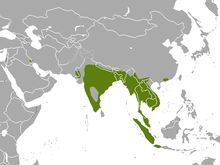Smooth-coated otter
| Smooth-coated otter | |
|---|---|
 |
|
| Scientific classification | |
| Kingdom: | Animalia |
| Phylum: | Chordata |
| Class: | Mammalia |
| Order: | Carnivora |
| Family: | Mustelidae |
| Subfamily: | Lutrinae |
| Genus: | Lutrogale |
| Species: | L. perspicillata |
| Binomial name | |
|
Lutrogale perspicillata (Geoffroy Saint Hilaire, 1826) |
|
 |
|
| Smooth-coated otter range | |
| Synonyms | |
|
Lutra perspicillata |
|
Lutra perspicillata
The smooth-coated otter (Lutrogale perspicillata) is a species of otter, the only extant representative of the genus Lutrogale. The species is found in most of the Indian Subcontinent and eastwards to Southeast Asia, with a disjunct population in Iraq. As its name indicates, the fur of this species is smoother and shorter than that of other otters.
Smooth-coated otters are relatively large for otters, from 7 to 11 kg (15 to 24 lb) in weight and 59 to 64 cm (23 to 25 in) in head-body length, with a tail 37 to 43 cm (15 to 17 in) long. They may be distinguished from other species of otters by a more rounded head and a hairless nose in the shape of a distorted diamond. The tail is flattened, in contrast to the more rounded tails of other species. The legs are short and strong, with large webbed feet bearing strong claws. As their name suggests, they have unusually short and sleek fur; this is dark to reddish brown along the back, while the underside is light brown to almost grey in color. Females have two pairs of teats.
Smooth-coated otters occur throughout much of the Indian Subcontinent and contiguous regions of Southeast Asia, in the Indomalaya ecozone. An isolated population of the species is also found in the marshes of Iraq.
Smooth-coated otters are found in areas where fresh water is plentiful — wetlands and seasonal swamps, rivers, lakes, and rice paddies. Where they are the only species of otter, they may be found in almost any suitable habitat, but where they are sympatric with other species, they avoid smaller streams and canals in favour of larger bodies of water. They have adapted to life in an aqueous habitat, but are nonetheless comfortable on land, and may travel long distances overland in search of suitable habitats.
Although they are often found in saltwater near the coast, especially on smaller islands, they require a nearby source of fresh water.
...
Wikipedia

